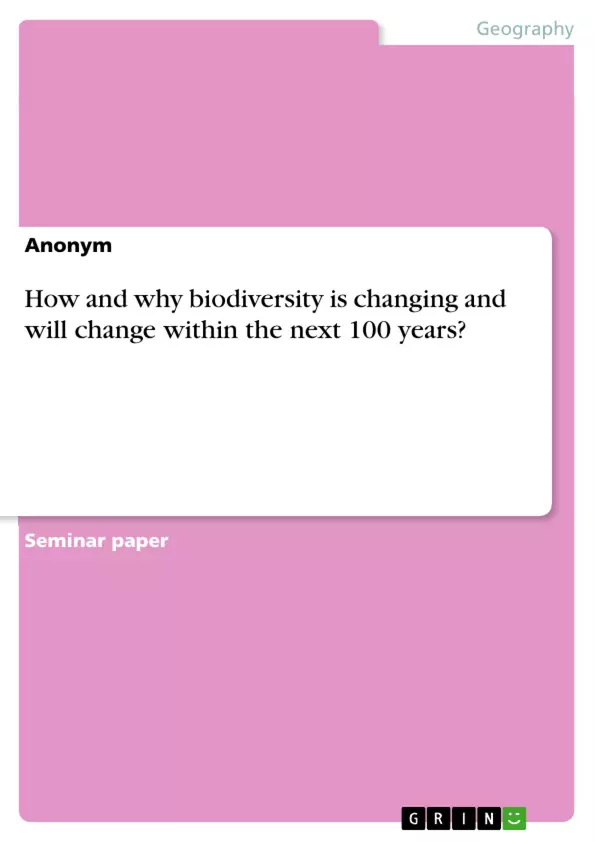This essay will first focus on the change in biodiversity by climate warming and then examine other influences like temperature change, invasive alien species, and land-use change - today and in the future.
Establishing the dimension of the changes in biodiversity, this essay considers negative, and positive impacts on biodiversity and suggests improvements and perspectives. As geodiversity determines biodiversity as well as ecosystem diversity, species diversity, and genetic diversity, it addresses the complexity of species richness and spatial scale in different biomes.
Biodiversity has changed and is changing temporarily with seasons and natural ecological disturbances. Nevertheless, anthropogenic influences amplify these processes changing biotic, abiotic, and movement factors. This affects biodiversity, ecosystem functions, and productivity which condition ecosystem services, and human well-being.
Inhaltsverzeichnis (Table of Contents)
- Biodiversity is currently changing and will change by climate warming
- Biodiversity is currently changing and will change by extreme weather events
- Biodiversity is currently changing and will change by invasive alien species (IAS)
Zielsetzung und Themenschwerpunkte (Objectives and Key Themes)
This essay explores the ongoing and projected changes in biodiversity over the next century. It analyzes the key drivers of these changes, including climate warming, extreme weather events, and the introduction of invasive alien species. The essay examines the impacts of these changes on different biomes and ecosystems, highlighting both the negative and positive consequences for biodiversity and ecosystem services.
- Climate Change Impacts on Biodiversity
- Extreme Weather Events and Biodiversity Loss
- Invasive Alien Species and their Role in Biodiversity Change
- Spatial Scale and Biodiversity Patterns
- Conservation Strategies and Perspectives
Zusammenfassung der Kapitel (Chapter Summaries)
- The essay first focuses on the impact of climate warming on biodiversity, specifically within the Arctic Tundra biome. It examines how changes in permafrost, ice shelves, and reflective surfaces contribute to long-term climate warming and its consequences for biodiversity. The essay discusses the impact of climate warming on plant and animal species, including niche shifts, earlier flowering and breeding, and altered migration patterns.
- Next, the essay explores the role of extreme weather events, particularly droughts, heatwaves, and floods, in shaping biodiversity. It highlights how temperature changes increase the frequency and intensity of such events, leading to habitat destruction, changes in ecosystem functions, and the spread of invasive alien species. The essay uses examples from the Lancang-Mekong River Basin to illustrate the impact of floods on biodiversity.
- The essay further examines the role of invasive alien species (IAS) in biodiversity change, particularly in riparian ecosystems. It analyzes the impact of IAS on native plant species, focusing on competition for resources and habitat displacement. The essay utilizes examples from the temperate broadleaf and mixed forests biome to demonstrate the consequences of IAS for biodiversity loss and species extinctions.
Schlüsselwörter (Keywords)
The essay focuses on key concepts like climate change, biodiversity, invasive alien species, extreme weather events, ecosystem services, geodiversity, spatial scale, and species richness. It examines the relationships between these concepts and their impact on different biomes and ecosystems, highlighting the significance of conservation strategies and perspectives.
- Quote paper
- Anonym (Author), 2022, How and why biodiversity is changing and will change within the next 100 years?, Munich, GRIN Verlag, https://www.hausarbeiten.de/document/1432081


